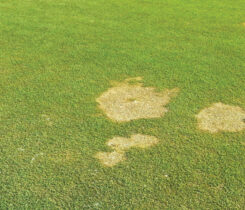How drones can help detect early drought stress in turf
Recently, interest has grown in whether drones can give an early warning of turfgrass stress on golf courses. Advances in drones and thermal imaging could provide opportunities to improve water management on golf courses, but research on this topic is limited.
Researchers at Kansas State University evaluated the ability to monitor canopy temperature imaging from a small drone to detect early drought stress in turfgrass. Mu Hong, Ph.D., Dale Bremer, Ph.D., and Deon van der Merwe, Ph.D., also compared the early drought stress detection ability of canopy temperature measurements from the drone sensor with handheld optical sensors

Color-enhanced thermal image of plots on June 15 (A) and Aug. 31 (B). Percentages denote fractions of reference evapotranspiration replacement. (Photo: USGA)
What is the relationship between drone images and handheld sensors for several turfgrass soil measurements? The turfgrass responses compared to drones and handheld sensors included volumetric water content, soil temperature, turfgrass visual quality and percentage green cover.
Bremer and van der Merwe conducted the study during the summer of 2017 on creeping bentgrass (Agrostis stolonifera) irrigated with 15 to 100 percent evapotranspiration (ET) replacements to impose a gradient of drought stress. Drone spectral reflectance measurements included three bands (near-infrared [NIR, 680-780 nm], green and blue bands [overlapped, 400-580 nm]) and eight derived vegetation indices
Relationship of canopy temperature and ET
Their results indicated canopy temperature via the drones detected rises of canopy temperature for the 15 and 30 percent ET plots compared with 100 percent ET plots. The detected change in canopy temperature corresponded with the decline in volumetric water content and was detected before drought stress became visible.
The results were comparable to the best spectral parameters on companion flights and canopy temperature closely correlated with spectral data from drone-mounted and handheld sensors. Thermal data strongly correlated with turfgrass visual quality and percent ground cover more than volumetric water content and soil temperature.
Detecting early drought stress due to an irrigation head not working or poor coverage days before you can see the problem may be helpful. Early detection of drought stress, as well as early stages of disease and insect activity, are areas where daily drone flyovers could help in the future.

Photo: Mike Kenna, Ph. D.
Mike Kenna, Ph.D., is the retired director of research, USGA Green Section. Contact him at mpkenna@gmail.com.












